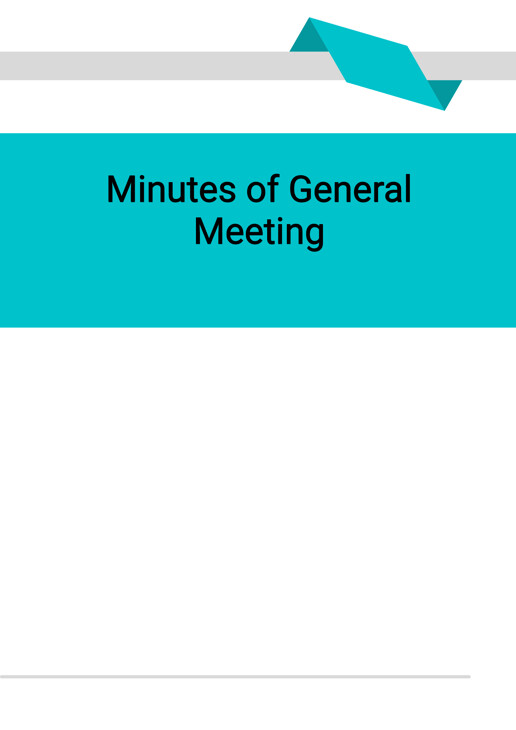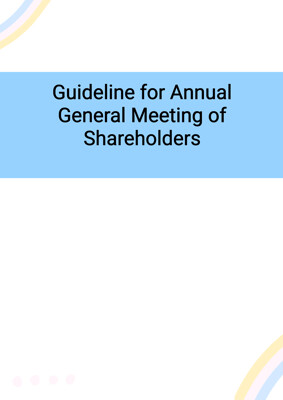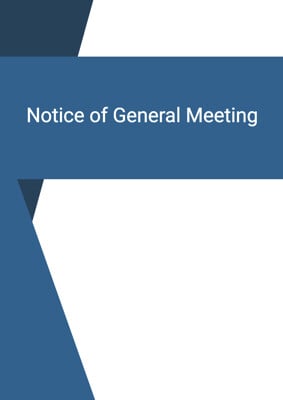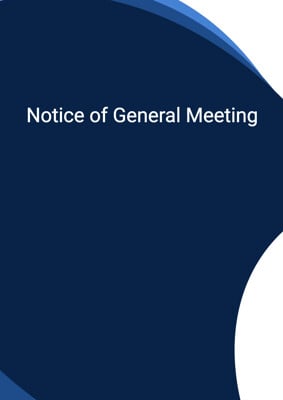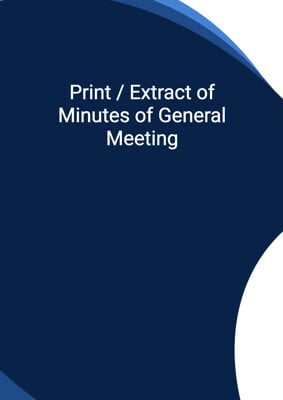How to Tailor the Document for Your Need?
01
Create Document
Click "Create Document" button and the document will be prepared with your account details automatically filled in.
02
Fill Information
Please fill in any additional information by following the step-by-step guide on the left hand side of the preview document and click the "Next" button.
03
Get Document
When you are done, click the "Get Document" button and you can download the document in Word or PDF format.
04
Review Document
Please review the document carefully and make any final modifications to ensure that the details are correct before publication / distribution.
Document Preview
Document Description
The document titled 'Minutes of General Meeting' is a record of the proceedings and decisions made during a general meeting of a company. It is an important document as it serves as evidence of the discussions and resolutions passed during the meeting. The detailed description of the document can be divided into two parts: the entire document and each section.
In the entire document, the title 'Minutes of General Meeting' clearly indicates the purpose of the document. It includes the company's account job and company registration number for identification purposes. The date, time, and place of the meeting are mentioned to provide context. The chairperson's name is also mentioned to establish authority.
The first section of the document is about general business matters. It covers various sub-sections such as quorum, minutes of the previous meeting, notice of meeting, and short notice (if applicable). The quorum is declared to be present, ensuring that the meeting can proceed. The minutes of the previous meeting are acknowledged as read and signed as a correct record. The notice convening the meeting is tabled and considered as read. If the meeting is called on short notice, it is reported that the members have agreed to the meeting being duly convened.
The second section of the document focuses on the sale of a subsidiary. It proposes the sale of the entire issued share capital of the subsidiary to a buyer. The terms and conditions of the sale are not mentioned in detail but are referred to as the 'sale.'
The third section of the document contains either special resolutions or ordinary resolutions, depending on the circumstances. In the case of special resolutions, specific actions are resolved, such as approving the sale, authorizing directors to sign agreements and documents, and ratifying previous actions. In the case of ordinary resolutions, similar actions are taken, but without the requirement of special circumstances.
If the document includes proxy information, it provides details of the number of votes exercisable by validly appointed proxies and how they were directed to vote. It also mentions the results of the poll taken on the resolution, including the number of votes cast in favor, against, and abstained. The outcome of the resolution is stated, whether it was adopted unanimously or lost.
Finally, the document is signed by the chairperson as a correct record of the meeting, along with the date and signature.
How to use this document?
To effectively use the 'Minutes of General Meeting' document, follow the step-by-step guidance below:
1. Review the document: Read the entire document carefully to understand the discussions and resolutions made during the general meeting.
2. Identify the purpose: Determine the importance of the document by recognizing its role as evidence of the meeting's proceedings and decisions.
3. Understand the sections: Familiarize yourself with the different sections of the document, including the general business matters, sale of subsidiary, and resolutions.
4. Note the quorum: Take note of the declaration of a quorum, which ensures that the meeting can proceed.
5. Acknowledge previous minutes: Recognize that the minutes of the previous meeting have been read, circulated, and signed as a correct record.
6. Consider the notice of meeting: Take into account the notice convening the meeting, which has been tabled and considered as read.
7. Assess short notice (if applicable): If the meeting is called on short notice, understand that the members have agreed to the meeting being duly convened despite the shorter notice period.
8. Understand the sale of subsidiary: Comprehend the proposal to sell the entire issued share capital of the subsidiary to a buyer, referred to as the 'sale.'
9. Differentiate between special and ordinary resolutions: Determine whether the document contains special resolutions or ordinary resolutions based on the circumstances.
10. Follow the resolved actions: Implement the actions resolved in the document, such as approving the sale, authorizing directors to sign agreements and documents, and ratifying previous actions.
11. Consider proxy information (if applicable): If the document includes proxy information, take note of the number of votes exercisable by proxies and how they were directed to vote.
12. Analyze the poll results: Understand the outcome of the poll taken on the resolution, including the number of votes cast in favor, against, and abstained.
13. Sign the document: If you are the chairperson, sign the document as a correct record of the meeting, along with the date and signature.
14. Store the document: Keep the 'Minutes of General Meeting' document in a secure location for future reference and compliance purposes.
Not the right document?
Don’t worry, we have thousands of documents for you to choose from:
